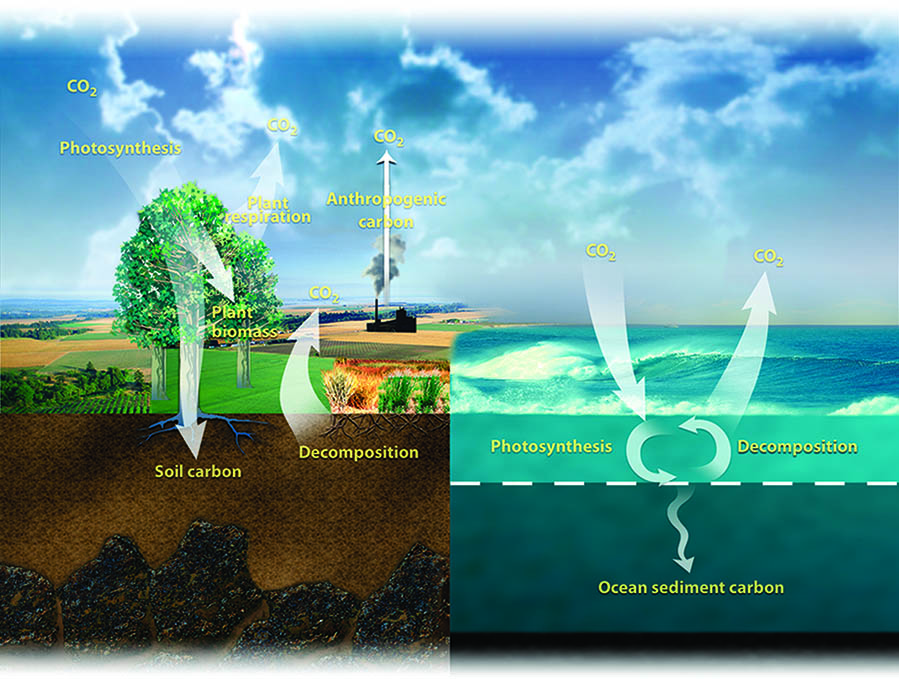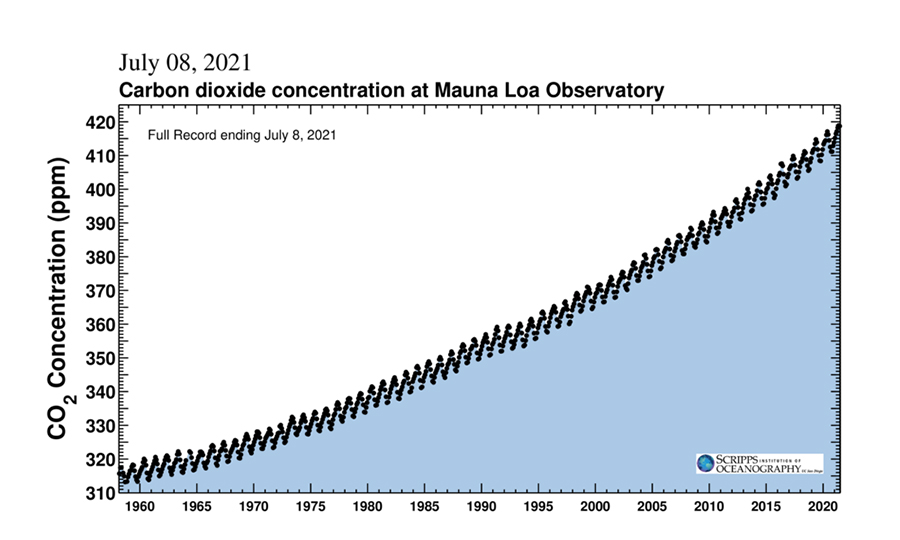
What is the Carbon Cycle and Why Should You Care?
by Sheryl Karas M.A., CRARS staff

Image credit: Office of Biological and Environmental Research of the U.S. Department of Energy Office of Science. science.energy.gov/ber/
Global warming/climate change is the result of heat-trapping greenhouse gases (GHGs) that are building up in the atmosphere, primarily due to human activity. One of the most significant GHGs is carbon dioxide (CO2), which not only heats up the atmosphere itself but considerably increases the amount of water vapor in the atmosphere. Water vapor (humidity) is itself a GHG and amplifies the warming effect of carbon dioxide.
Luckily for us, there is a natural mechanism—the carbon cycle—that we can work with to try to solve this problem. The carbon cycle is a series of processes where carbon is converted into a form that can be used by plants and other living things through photosynthesis. CO2 is then released back into the atmosphere through respiration or the decay of dead organisms. That’s not typically a concern. The issue is that we have increased carbon emissions so dramatically through burning of fossil fuels and modern agricultural practices that the natural carbon cycle cannot keep up. As a result, excessive CO2 has built up in the atmosphere—where it is warming the planet—and in the ocean—where it is acidifying that environment and harming marine life. Most of this has happened since the 1950s and is continuing at an alarming rate.

Used with permission by Scripps Institution of Oceanography
On the other hand, we have other reservoirs (“sinks”) for carbon that are currently underutilized—the forests and the soil. In fact, both of those have been disappearing because of deforestation and soil erosion due to modern day agricultural practices. But if managed correctly those resources—in conjunction with dramatic reductions in carbon emissions—could tip the balance back in our favor. That’s where regenerative agriculture comes in. Climate-beneficial practices such as keeping the ground covered with mulches or living plants and leaving roots and soil microbe communities intact go a long way towards preventing soil erosion and allowing the land to act as a carbon sink. Managed grazing and use of compost allow more carbon to accumulate underground, and other practices like silvopasture, alley cropping, and the use of windbreaks draw down more CO2 via photosynthesis. These approaches are also known as tools for “carbon farming” because the result is the potential for enormous amounts of carbon being stored/sequestered safely in soils and long-lived vegetation. That helps improve the quality of the soil and on-farm microclimate and biodiversity, as well as the temperature of the planet.
The good news is that there is greatly increased interest in using agriculture as part of the solution to climate change. Not only does it have the potential for stopping the progression of climate change, but it could also even play a significant role in reversing it if adopted more widely. At the very least carbon farming shows great promise for resiliency in terms of food production and farm livelihoods by greatly reducing soil erosion and by storing soil carbon to rebuild nutrient-rich topsoil. Greenhouse gas reduction using these approaches can also be tracked and quantified using tools like the COMET-Farm(opens in new window) and Comet-Planner tools(opens in new window) developed by the USDA Natural Resources Conservation Service and Colorado State University and others. That means we can monitor the effectiveness of carbon farming choices and have already begun to do so. Three reports that present findings on agricultural practices and carbon sequestration in California are available to the public on the CA.gov website now(opens in new window).
Working with the Carbon Cycle Institute
One of the key organizations working to support the adoption of carbon farming in the United States is the Carbon Cycle Institute (CCI)(opens in new window). CCI has been developing a model framework for land management that is organized around the carbon cycle using data from the COMET-Planner(opens in new window) and COMET-Farm(opens in new window) tools and over 80 years of soil conservation experience. The process is called Carbon Farm Planning and utilizes a whole-farm approach to develop comprehensive farm plans for maximizing on-farm carbon capture and enhancing important ecosystem functions such as providing wildlife habitat, increasing water quality and storage, and supporting biodiversity. CCI provides training and educational programs for farmers and ranchers, technical service providers, conservation agencies and organizations, and policymakers. They also provide training for Carbon Farm Planners and support community and national policies that promote the spread of this work.
The Center for Regenerative Agriculture and Resilient Systems (CRARS) at Chico State has developed a strategic partnership with the Carbon Cycle Institute (CCI) to increase training and education opportunities in regenerative agricultural practices for students, producers, and conservation planners and agency staff. These opportunities support agricultural workforce development and will accelerate the development and implementation of Carbon Farm Plans throughout Northern California.
Two USDA-funded programs have been recently awarded to the CRARS to support this priority.
Awarded through the National Institute of Food and Agriculture (NIFA) Non-Land Grant Colleges of Agriculture (NLGCA) program, the CRARS is developing a series of online courses in regenerative agriculture. These courses contribute to undergraduate education, as well as to professional development for conservationists and natural resource management professionals.
Recently awarded through the Natural Resource Conservation Service (NRCS) Regional Conservation Partnership Program (RCPP) program, the CRARS will lead a collaborative effort with partners across the Northern California region to provide technical assistance and financial support to producers to implement conservation plans with a focus on soil health to increase carbon sequestration among other benefits.
Exciting developments!
Learn about the science related to the carbon cycle.(opens in new window)
Watch recordings of CCI’s 2020 monthly open discussion “Café Hour” training series workshops.(opens in new window)
View materials from carbon farming presentations(opens in new window) CCI and CRARS have done together.
